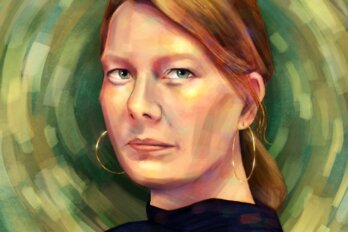Marie-Claire Blais’s Songs for Angel is achingly contemporary: it covers white supremacist massacres, suicide bombings, trans rights, and online shaming. The entire novel is also a single sentence that slides through the perspectives of dozens of characters before it reaches a period on page 201.
It would be a singular achievement—except Blais has been doing this for decades. Her career stretches back to 1959 and includes more than twenty other novels in addition to theatre, radio plays, poetry, and nonfiction. She is so prolific that, in Quebec, it is easy to take her for granted. Songs for Angel (or Des chants pour Angel), newly available in a confident translation by Katia Grubisic, is the ninth novel in Blais’s Soifs cycle, which began in 1995 and concluded with a tenth book in 2018. (Soifs translates literally as Thirstings.) The series follows the lives of a diverse cast in Key West, including lawyers, artists, housekeepers, and sex workers. The books are all written in the same distinctive style: solid blocks of stream-of-consciousness text that shift between viewpoints with few to no sentence breaks.
House of Anansi Press has faithfully published each of the titles in the cycle, books that deserve far more attention from English readers. But embracing a novel like Songs for Angel requires belief in an old-fashioned form of brilliance, one that sacrifices accessibility on the altar of artistic vision. Prose aside, Blais’s interpretations of today’s headlines can be tantalizingly old school. Songs for Angel deploys the most omniscient of narrators, crossing lines of gender, race, class, and sexual orientation with seeming little compunction. While Blais is deeply invested in social justice, her approach is far removed from controversies about positionality and cultural appropriation that have rocked the anglophone world. Indeed, she resists being read in such terms. In an age of identity politics, Songs for Angel remains committed to something like the universal human experience.
To put all this another way, anyone nostalgic for the literary experiments of the 1920s can rejoice. The twenty-first-century heir to modernism happens to be a francophone octogenarian woman in Florida.
Blais’s most widely known novels, in Quebec and the rest of Canada, may still be her early Gothic depictions of French Canadian life: her first book, the dark fairy tale La belle bête, translated as Mad Shadows, and her fourth, 1965’s A Season in the Life of Emmanuel. Published while Blais was still in her twenties, each details a dysfunctional family and alternately shocked and thrilled readers when they were first released.
Perhaps it is not surprising that A Season in the Life of Emmanuel remains a staple of the Québécois canon. The novel describes the degradation of a poor rural family so large that one of the children is referred to as “the Seventh.” The protagonist, Jean Le Maigre, writes poems in Latin and Greek that his grandmother reuses as toilet paper. When his experimentations with sex, alcohol, and arson are cut short by tuberculosis, the narrative shifts to other siblings, including a sister who works in a brothel and enjoys it. Too abject to represent a national tradition, this book is nevertheless recognizable within one. It features a hypocritical and oppressive Catholic Church, a father too busy with cows to raise his children, and plenty of snow.
Since then, Blais’s work has moved further afield. She has published a novel roughly every two years, including A Literary Affair’s satire of Parisian pretension and an exploration of the lesbian bar scene in Nights in the Underground. In the process, she has won nearly every prize worth mentioning, including France’s prix Médicis and four Governor General’s Awards. She has also become increasingly difficult to categorize. Though queer characters appear in her work and she had a long-term relationship with American artist Mary Meigs, Blais dislikes being called a lesbian writer. By setting her ten-novel magnum opus in her adopted home of Florida, she appears to shrug off any obligation to write about Quebec.
Blais also shows little interest in speaking for herself. Instead, the Soifs novels aim to channel an entire temporal and cultural moment. It is no surprise that she has a strong academic following. Her long sentences, which drift from mind to mind, seem to deconstruct the notion of the individual (everyone is connected) and of objective reality (we can access the world only through interpretation). Whoever your favourite theorist or philosopher may be, Blais has something to say to them.
This fiction is as highbrow as it comes. In a 2019 article for The New Yorker, Pasha Malla likens Blais’s style to “the Woolf of ‘The Waves’; Proust, in his approach to recollection; Faulkner, in his use of polyphony.” The connections are thematic as well as stylistic. Like Proust’s, Blais’s work includes plenty of dinner parties and meditations on high art; like Faulkner, she is preoccupied by race relations and the alternating beauty and horror of the American South. The books in the Soifs cycle are also temporally and geographically unstable. The dominant setting evokes Key West, configured here as a crossroads between the US and the Caribbean where the privileged and dispossessed live side by side. But the books don’t follow a linear timeline, and some narrative digressions spiral out across continents.
These challenges have left some critics wondering whether the Soifs novels are readable at all. Marianne Ackerman, in the last consideration of the cycle published in The Walrus, in 2009, concludes that they are, barely—provided you are willing to go slow. Another strategy is to simply accept confusion and push onward. Though characters recur between novels, evolving and aging and even dying, the series is driven more by abstract reflections than by plot. One character in Songs for Angel observes, “The world was populated by demons, fanatics both secular and religious, nothing seemed to be able to prevent their rise and our ruin.” Pages later, others pick up the thread to despair over new bills that discriminate against trans people and to compare abusive fathers to “men who terrorize everyone with their ghastly bombs in European airports.” These books work through resonance and juxtaposition. It is more important to follow the themes than to keep track of who’s who or what exactly is going on.
The series also doesn’t need to be read in order. As a place to start, Songs for Angel is arbitrary but not impossible. The novel opens as an elegy: a set of Black and queer characters head to the ocean to scatter the ashes of Angel. (He was dying from AIDS in the eighth novel.) From the shore, they glimpse a boat filled with migrants in distress, “the damned of the earth,” too far off to be helped. The narrative then shifts into the mind of Daniel, a well-off writer whose reflections add a metafictional element to the text. He agonizes over his role as “a controversial, questionable judge” and attacks the naive belief that “a tyrant or a head of state hell-bent on destroying humanity might be sensitive to a novel or a poem.” Still, he keeps writing, and so does Blais.
Previous translators had their hands full making these books, and their epic comma splices, work in English. They have also been recognized for their efforts: Nigel Spencer, responsible for seven of the previous Soifs translations, won three Governor General’s Awards for his work.
Katia Grubisic is new to Blais with Songs for Angel. A poet in her own right, she deftly recreates the original’s momentum, propelling the reader from phrase to phrase. She notably reduces the repetition in the original prose, opting for synonyms in places where Blais uses the same word. Her boldest choice is her rendering of the novel’s final lines: “quelle douceur fut notre traversée, Lumière du Sud, Lumière du Sud.” The French ends by twice naming Daniel’s family sailboat, a repetition that recurs like an incantation throughout the original but which Grubisic often trims in her English version. Instead, she gives us: “how sweet was our crossing, Southern Light, light of the south.” This shift in phrasing breaks the spell of the proper name to end with an image of hope. The decision seems at once like too great a liberty and a stroke of genius, lending these final lines a satisfying weight.
Grubisic’s success aside, one senses a generational and, perhaps, political divide between writer and translator. Her contribution to the expanded new edition of Sherry Simon’s Culture in Transit: Translating the Literature of Quebec considers issues of intersectionality, commenting on the pervasive whiteness of literary translators. Labelling herself a white cis settler, Grubisic describes her hesitation over translating Haitian Québécois writer Stéphane Martelly.
Blais betrays no such concern about entering the mind of Petites Cendres, a queer mixed-race drag queen. Beyond her recurring cast, the book focuses above all on the Young Man. A depressingly familiar figure, he slaughters fifteen Black parishioners in a church in the hopes of spearheading a new movement of white supremacist youth. The narrative details his tortured fantasies, probing for motive and remorse, asking what society owes its assassins.
With such a premise, Blais’s work, were it easier to read, might be contentious. Controversial, even. Who is this white woman to grant herself access to all these psyches? And why the fascination with racist murderers over their victims? Blais responds, eccentrically enough, by channelling a Russian. In an interview with La Presse, she describes the Young Man as a “murderer in the style of Dostoevsky. Someone ordinary, who believes he is performing an extraordinary deed . . . someone who claims a false heroism.” There are certainly shades of Raskolnikov, the conflicted student from Crime and Punishment. Sitting in his parents’ basement, the Young Man plans his massacre because “his existence . . . would have been dull otherwise” and insists that he is “in control of his life, because he had an idea to top them all.”
Though Blais has denied the connection, the Young Man can’t help but call to mind Dylann Roof and his 2015 murder of nine churchgoers in Charleston, South Carolina. But Blais’s fictionalized killer is, importantly, only seventeen. (Roof was twenty-one.) Combined with his namelessness, this gives him an archetypal quality. He is also frequently described as “virginal.” Paradoxically, his decision to kill seems to require a form of innocence, or at least naïveté.
While Blais is not so gauche as to set the Young Man on a path to redemption, she refuses to frame him as uniquely evil. Instead, she asks, in the style of Dostoevsky’s The Brothers Karamazov, about our collective responsibility for one another. Lawyers and pastors debate whether the Young Man should be executed or whether his victims’ Christian faith demands mercy. Blais also brings in other troubled and tragic youth from the headlines. A thirteen-year-old girl jumps from a highway overpass after her father chops off her hair and puts the video on YouTube; named Suzannah here, she is clearly based on the 2015 case of Izabel Laxamana. Meanwhile, a twelve-year-old girl rigged up as a suicide bomber somewhere in the Middle East decides against mass murder. She runs through fields in search of help to defuse the instruments of death circling her waist.
Taken together, these stories suggest that white supremacy, domestic abuse, and religious extremism have a similar source: the dark but human desire to simplify the world through violence. Also at stake is how the rest of us respond to these mediated visions of horror. The writer Daniel captures our state of oversaturation: “we felt blame and discomfort at living in such a universe, dark and cruel, and then we felt nothing, as if the world was no longer any of our concern.”
In the end, Blais does not advocate for this disaffection. Her writing takes up such a wide range of viewpoints in order to insist on our shared humanity. The very structure of the novel challenges social hierarchies as her single long sentence grants her speakers an almost grammatical equality. For those who are up to the challenge, Songs for Angel is a daring aesthetic experiment and a powerful appeal to solidarity.





